March 27, 2015
Air Date: March 27, 2015
FULL SHOW
SEGMENTS

Obama Slashes Federal Global Warming Gases
View the page for this story
President Obama orders the US government to slash federal global warming gas emissions by 40 percent over the next decade. The Obama Administration also cuts off disaster preparedness funding for those states that refuse to acknowledge the risks of climate disruption. The Union of Concerned Scientists’ climate policy manager Rachel Cleetus discusses these policies with host Steve Curwood. (06:35)
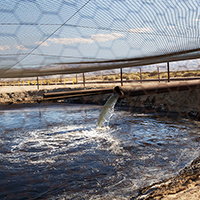
New Fracking Rules Protect Groundwater on Federal Lands
View the page for this story
Hydraulic Fracturing – fracking – has helped the US become the top producer of oil and gas. Now the Obama administration has announced new rules for fracking on federal lands to help protect groundwater. ProPublica environmental reporter Abrahm Lustgarten tells host Steve Curwood how the rules will help create guidelines for industry practices. (06:00)

Melting Ice Slows Down Ocean Circulation
View the page for this story
The Atlantic Conveyor Belt is a system of ocean currents that bring warm temperatures and important nutrients to the waters off of East Coast America and Western Europe. But as global warming melts ice in Greenland, the influx of fresh water seems to be slowing the northward drift down and could shut the system down altogether. Climate scientist Michael Mann tells host Steve Curwood that could spell trouble for the ocean and the economy. (09:30)
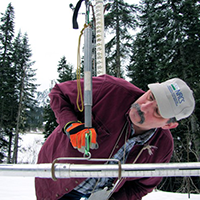
What a Record-Low Snowpack Means for Summer in the Northwest
/ Ashley AhearnView the page for this story
Snowpack is important for summer life in the Northwest. In the winter, snow accumulates on mountaintops and as temperatures rise, snowmelt recharges water systems and generates hydropower throughout the region. This year, snowpack is at record low and many fear that the supply might not last through the entire summer. But as EarthFix’s Ashley Ahearn reports, it’s not time to hit the panic button just yet. (03:50)
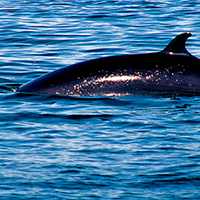
Beyond the Headlines
/ Peter DykstraView the page for this story
In this week’s trip beyond the headlines, Peter Dykstra discusses Japan’s refusal to eat twhale meat contaminated by toxic chemicals that bio-accumulate in the ocean food chain with host Steve Curwood as well as more evidence of the governor of Florida’s alleged antipathy to climate change-related words, and President Obama’s ill-timed confidence in the safety of oil rigs. (04:50)

Defending Darwin
View the page for this story
The University of Kentucky, is located in the heart of the Bible Belt, a region with many Fundamentalist Christians who are skeptical of the theory of evolution. Today, Jim Krupa is a biology professor at UK who has taught evolution to thousands of students, some of whom believe that the idea of evolution, as posited by Charles Darwin, is fraudulent and the Earth and its creatures are only about 6000 years old. Prof. Krupa tells host Steve Curwood that despite opposition from some students, he’s following in the footsteps of UK educators who have defended academic freedom and scientific fact. (17:10)
Show Credits and Funders
Show Transcript
HOST: Steve Curwood
GUESTS: Rachel Cleetus, Abrahm Lustgarten, Michael Mann, Jim Krupa
REPORTERS: Ashley Ahearn, Peter Dykstra
[THEME]
CURWOOD: From Public Radio International, this is Living on Earth.
[THEME]
CURWOOD: I'm Steve Curwood. Weather across the US has been unusual this winter – record snowfalls in the east, a lack of snow, record warmth, and drought in parts of the west – and many wonder if climate change is to blame.
SNOVER: When people ask me about this year and whether this is global warming I say, well, global warming looks like this, and I also say we’ll see a lot more of these, more frequently, as we go forward.
CURWOOD: Lessons for the future. Also, in Kentucky, teaching evolution can be perilous and so is explaining climate change.
KRUPA: Same kind of push back. Comments about I shouldn't be teaching it, it's not true, there's no evidence; that's not connected to religious beliefs, that's rejection of the science.
CURWOOD: Science teaching in the face of fundamentalism in the Bible belt. We’ll have those stories and more this week on Living on Earth. Stick around.
[NEWSBREAK MUSIC: Boards Of Canada “Zoetrope” from “In A Beautiful Place Out In The Country” (Warp Records 2000)]
ANNOUNCER: Support for Living on Earth comes from United Technologies – innovating to make the world a better, more sustainable place to live.
Obama Slashes Federal Global Warming Gases
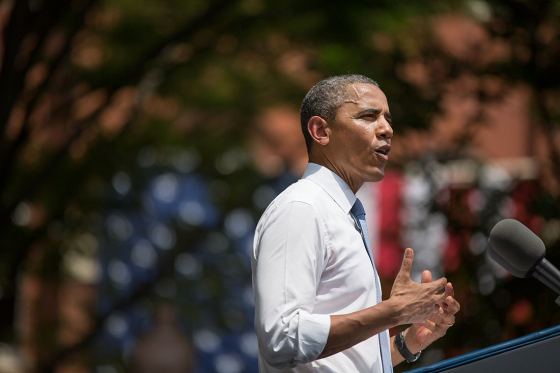
President Obama unveiled his Climate Action Plan (CAP) on June 25th, 2013 in a speech at Georgetown University. Rachel Cleetus says the new Executive Order directing the federal government to curb its own greenhouse gas emissions is one of many individual actions that help fulfill the President’s plan. (Photo: Pete Souza/White House; CC government work)
CURWOOD: From the Jennifer and Ted Stanley Studios in Boston and PRI, this is Living on Earth. I’m Steve Curwood. There’s a new executive order that directs the Federal Government to deeply cut greenhouse gas emissions and increase renewable energy use within its own operations. It’s part of the Climate Action Plan President Obama unveiled almost two years ago. In addition, the Federal Emergency Management Agency, FEMA, will only grant disaster preparedness funds to states that factor climate risks in their hazard mitigation plans. Here to explain these announcements is Rachel Cleetus, Lead Economist and Climate Policy Manager at the Union of Concerned Scientists.
CLEETUS: What they announced was they would be cutting federal government greenhouse gas emissions 40 percent over the next decade, and they also announced some major commitments to 30 percent of their renewable sources. In June of 2013, the president laid out a vision for his climate action plan, and what we're starting to see, some meat on the bones here. They are many pieces, both to help guide emissions, as well as to help build our nation's resilience to climate impacts. And we've seen some of those pieces be announced over a year and a half, including things like a draft proposal to limit carbon emissions from power plants, vehicle standards, steps to cut methane emissions, and this is simply another piece.

As the U.S. Department of Defense is the nation’s largest energy consumer, reducing greenhouse gas emissions and increasing clean energy use within the federal government can have a significant impact. (Photo: US Air Force; Flickr CC BY-NC 2.0)
CURWOOD: To what extent does this federal order stimulate activity in the private sector?
CLEETUS: It's a very significant step in this direction, and that was evidenced by the fact that when the executive order was announced there was a business roundtable that was also convened among the largest government suppliers of energy and energy technology, and we saw a number of businesses including GE, Honeywell and others make commitments to cut their greenhouse emissions as well. We're not just getting the federal government making cuts, but we're pulling along an entire supply chain that's also being greened.
CURWOOD: To what extent does this stimulate the broader economy to take these green options? You know, many years ago, President Clinton issued an order requiring the federal government to use recycled paper and it's now ubiquitous.
CLEETUS: It's very interesting because what we're seeing here is a bit of push-pull. Sure the federal government is taking leadership, but actually there are many states around the country that have already been demonstrating leadership on clean energy progress whether it's in deploying renewable energy in wind and solar or implementing standards to improve energy efficiency, and what we've seen in the marketplace is a dramatic fall in costs of wind and solar. So you can see that the federal government is joining the party now. They're taking advantage of these cost effective, low-carbon energy resources.
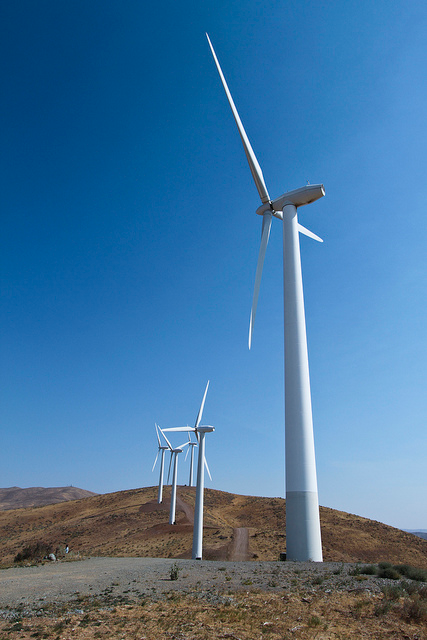
Cleetus also points to the vast federal public lands as opportune places to develop clean energy. Here, wind turbines in the first wind farm on BLM land in Oregon top a ridgeline. (Photo: BLMOregon; Flickr CC BY-SA 2.0)
CURWOOD: In your view, you see the federal government as a follower here, rather than a leader, it sounds like.
CLEETUS: I think they're doing a bit of both. They're taking advantage of market realities, but the other thing they're doing is that they're setting a bar for the nation as a whole. This is what's possible when one of the biggest players in the energy market takes a step like this. Think about the Department of Defense, for example, a huge energy consumer. Think about all those public lands in which you can site wind and solar resources. There's a real opportunity here, and I think they're pointing the way to that opportunity and the economic benefits that it can bring.
CURWOOD: What will this cost the federal government?
CLEETUS: Well that's the interesting thing; because the costs of these technologies have fallen so much that they're saving taxpayer's money, up to $18 billion dollars in avoided energy costs. Not just from renewable energy, but also from energy efficiency, and that doesn't even take into account that it’s bringing many other energy benefits along with it, so when we transition to low carbon energy resources we generate economic benefits. We also cut other pollutants that have big public health costs.

General Electric, which is a major federal government supplier, was one of several large companies that joined the roundtable convened by the Obama Administration to discuss corporate plans to reduce greenhouse gas emissions in tandem with the federal government. (Photo: Thomas Hawk; Flickr CC BY-NC 2.0)
CURWOOD: What have federal agencies already done to cut their energy use?
CLEETUS: Well, a number of federal agencies have already made commitments around building efficiency, around reducing their water consumption, and what this executive order does is essentially streamline and make some uniform commitments across different federal government agencies, as well as the supply chain that meets the energy demands of these agencies.
CURWOOD: Rachel, I want to turn our attention now to this recent announcement from the Federal Emergency Management Agency, FEMA, which has said now it will prepare emergency disaster funds only for those states whose governors have signed hazardous mitigation plans that directly address climate disruption. How might this put pressure on governors like Rick Scott of Florida or Bobby Jindal of Louisiana who so far have refused to take action on climate despite a number of people’s concerns from people that their states are highly vulnerable to the impact of climate disruption?
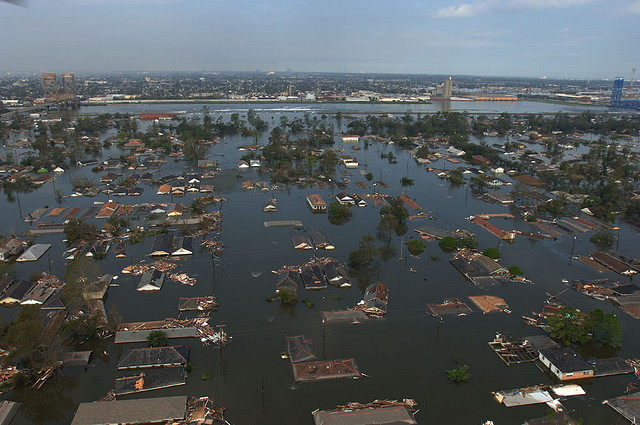
The new FEMA guidelines, which will go into effect next year, require state governors to approve hazard mitigation plans that address climate change if they hope to receive funding for disaster preparedness. (Photo: Kelly Garbato; Flickr CC BY-NC 2.0)
CLEETUS: I want to start by saying that the science of climate change is firmly established. We know that these risks are here, we saw them clearly outlined in the National Climate Assessment that was released last year pointing out a number of risks that the US faces, including sea level rise, drought, increased precipitation, wildfires, so it's unfortunate that we're having a partisan conversation about this. What the guidance does essentially is, it says that we know there are many factors that affect these kinds of disasters and their occurrence, and one of the major risk factors now is climate change. So it's common sense that you would include it in your plans as you prepare for future disasters. FEMA provides this money so that states can invest in a variety of ways to make sure that when a future disaster happens they're better prepared. To be very clear, this new FEMA guidance does not affect disaster relief, the kind of money that goes into the immediate aftermath of a terrible tragedy - a big storm, a big fire. What it does affect is what's called FEMA's Hazard Mitigation Assistance Program, and that's a program that essentially helps states prepare before the next disaster strikes.
CURWOOD: What are some of the examples of the climate induced hazards that the states hazard mitigation plans will need to address?
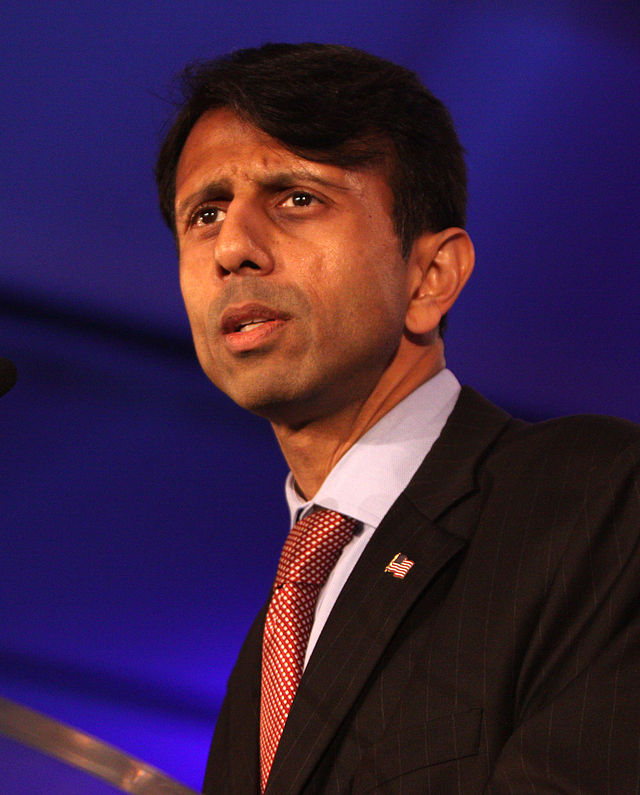
Louisiana Gov. Bobby Jindal blasted the FEMA funding requirement to address climate change, calling it “political leverage.” Jindal’s state is among those most vulnerable to the impacts of climate change, including rising sea level and intensified hurricanes. (Photo: Gage Skidmore; Wikimedia Commons CC BY-SA 3.0)
CLEETUS: Right. So, for example, we know there are many coastal states that are already experiencing sea level rise and that the science projects sea level rise is only worsening over time so that their risks of coastal flooding or storm surge are only increasing. When any investments are being made to help prepare a state for future disasters, you would want to take into account this very real scientific fact.
CURWOOD: Rachel Cleetus is the Lead Economist with the Climate and Energy Program at the Union of Concerned Scientists. Rachel, thanks for taking the time to speak with us today.
CLEETUS: Thank you very much for having me on your program, Steve.
Related links:
- “Fact Sheet: Reducing Greenhouse Gas Emissions in the Federal Government and Across the Supply Chain”
- Executive Order: Planning for Federal Sustainability in the Next Decade
- “FEMA to States: No Climate Planning, No Money”
New Fracking Rules Protect Groundwater on Federal Lands
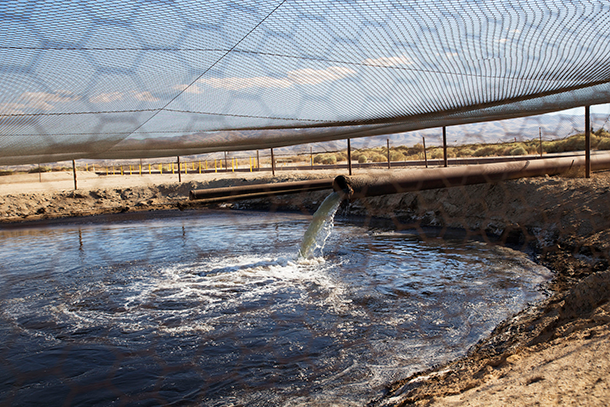
Under the new federal fracking rules, wastewater must be managed onsite and in closed tanks, not open pits seen here. (Photo: Sarah Craig/Faces of Fracking; Flickr CC By-NC-ND 2.0)
CURWOOD: America is now the world’s biggest producer of crude oil and natural gas, thanks to the technology of hydraulic fracturing. Along with profits, so-called fracking has also generated a fair amount of controversy, from concerns about water and air pollution to apparently related earthquakes. There is currently a patchwork of state regulations for fracking, including an outright ban in New York State, and now the federal government has released regulations for fracking on federal lands. Joining us now to discuss the rules is Abrahm Lustgarten, a reporter with ProPublica who covers the energy industry. Welcome back to Living On Earth, Abrahm.
LUSTGARTEN: Thank you. Nice to be here.
CURWOOD: So, these regulations are limited to federal lands. How much of the fracking that’s happening right now is on federal land?
LUSTGARTEN: I think the official statistics are somewhere along 100,000 wells. So that's going to be about 10 percent of the drilling that's happening in the United States. So the most significant place right now is the Bakken Shale. About half, a little less than half of the drilling in the Bakken Shale is on the Fort Berthold Indian reservation. Besides the Bakken, central Wyoming, northern Colorado, parts of California all have very large tracts of federal lands. Tens of thousands of wells and there will be new wells coming in the future, and they will all be subject to these rules.
CURWOOD: So, specifically, what will these regulations do now?
LUSTGARTEN: Well, the regulations essentially update existing regulations, and there are essentially new regulations to protect groundwater from damage that can be caused by the fracking process. So, they're aimed squarely at insuring that wells are constructed well. So they have some requirements for how cement casing will be installed around the structure of an oil or gas well, around how you'll test that cement casing to make sure that it withstands pressure, they’ll do what’s called mechanical integrity tests which are a really important examination to make sure that there can't be any leaks. They'll require a geological analysis of the area around a new well to, in part, determine whether there's fractures or natural fault lines or anything else underground that might allow chemicals or fluids to leak into a surrounding or nearby aquifer. And finally, they'll require that waste temporarily be handled at fracking sites in closed containers, basically in steel tanks instead of the open waste pits that have also been associated with groundwater or pollution across the country.
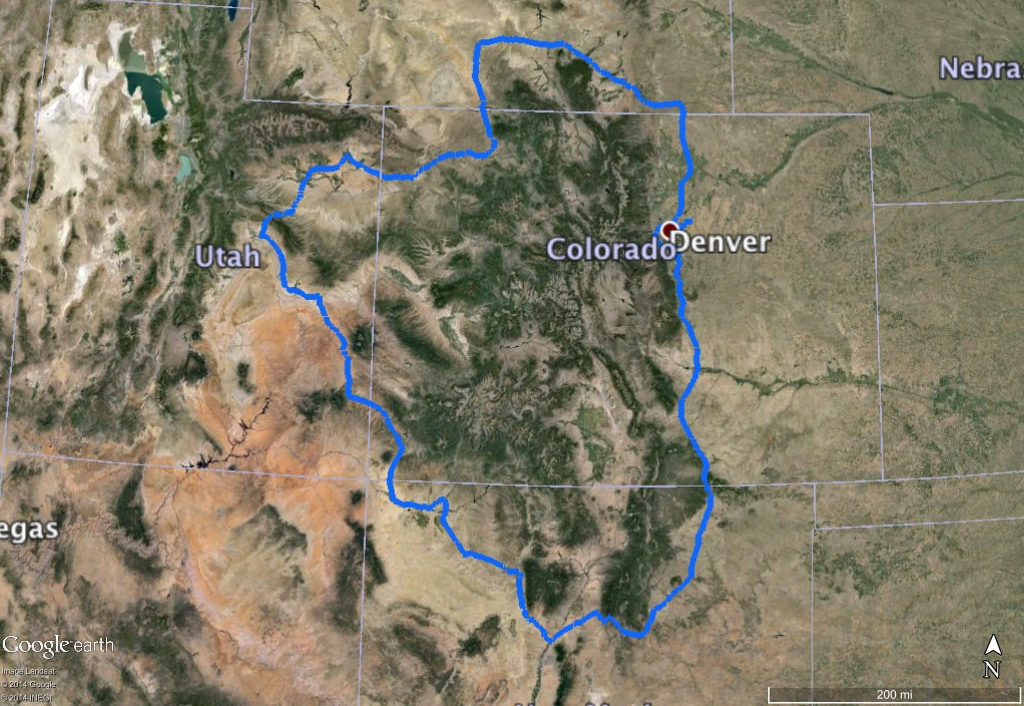
Fracking on federal lands in the Colorado (Photo: WildEarth Guardians; Flickr CC BY-NC-ND 2.0)
CURWOOD: So, tell me the chemicals that are at risk of getting into groundwater.
LUSTGARTEN: Well, there's a very long list of chemicals that are known to be used in fracking, but there's types of them. There's basically biocides that are meant to kill algae, there's surfactants, which is like a soap that's meant to kind of lubricate the inside of a well, and a couple of other classes of chemicals. And part of the problem is, we don't know what the complete list is, and we don't know that because the oil and gas drilling companies have protected that information as trade secrets. And part of the new rules for BLM lands is requiring oil and gas companies to release that information, or at least a lot of that information.
CURWOOD: How is industry responding to these rules?
LUSTGARTEN: Industry, is, with very familiar refrains, fighting these rules. The American Petroleum Institute immediately filed a lawsuit to stop the rules from taking effect, and the industry across the board has said repeatedly that it will be expensive and onerous and will probably disincentivize investment and drilling on federal lands and lower federal income related to that drilling and so forth. But basically, it seems to be a very thin argument. I've looked a bit at the costs, including the industry's own cost estimates. They're as high as about one and half percent of the cost of drilling a well. The Department of Interior estimates they are as low as one-tenth of one percent the cost of drilling a well. The total cost across the country is estimated to be about $350 million dollars a year. When you consider tens of billions of dollars in profits for each of these companies, it's a very insignificant amount, and at the same time, many of these states actually have state regulations that are as strict or more strict as these new federal rules so, they're already able to comply, they're already assuming the heightened costs of regulations in places in Wyoming on state lands or private lands. And I just don't see these new federal rules as being too much of a roadblock to industry.
CURWOOD: What about the critics of hydraulic fracturing, those environmental activists who focus on energy extraction, what's been their response to the rules?
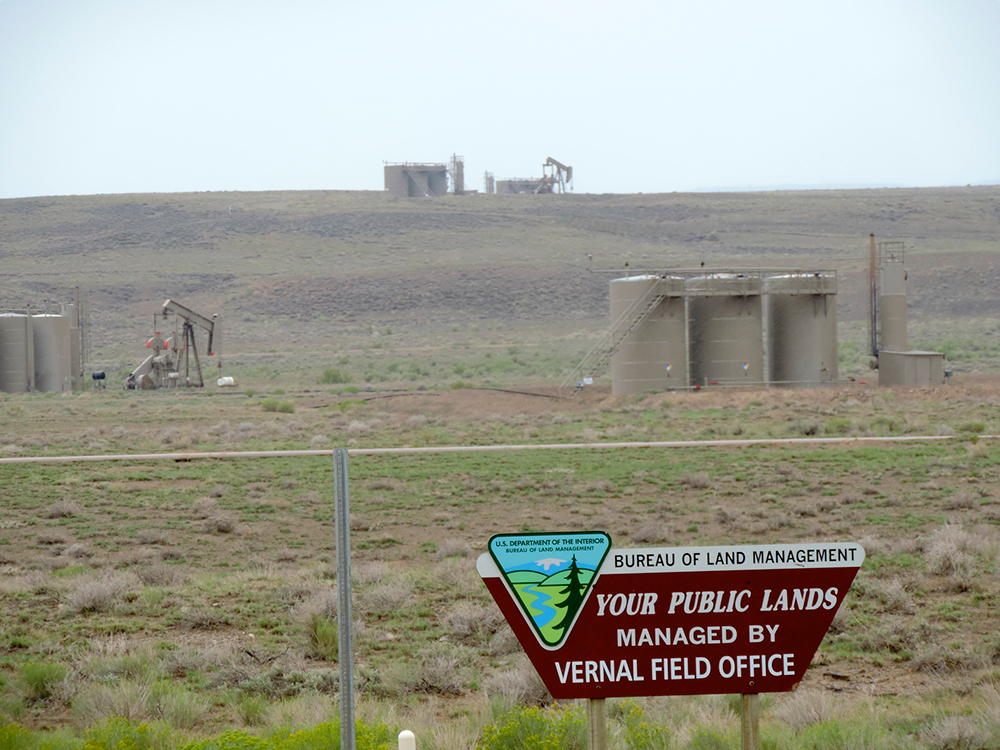
The Bureau of Land Management (BLM) helps regulate federal land use, including the fossil fuel mining industry. (Photo: WildEarth Guardians; Flickr CC BY-NC-ND 2.0)
LUSTGARTEN: Tepid at best. They, of course, wanted more. Their central criticism is the Obama administration has taken a path towards addressing climate change and that hydrocarbon development should not be allowed on federal lands. They want other requirements as well. They wanted the disclosure of chemicals to come without any sort of caveats without any exemptions for proprietary information, and they want some specific technical details around the well construction requirements described earlier, just things that are incrementally more stringent than what's actually been put in place.
CURWOOD: So, Abrahm, at the end of the day, how important are these new federal rules on fracking?
LUSTGARTEN: Well, it's kind of a mixed bag, but to the extent that federal lands, particularly in the western United States are an important source of oil and gas and will continue to be, this will substantially mitigate the risks that regulators have been seeing and that residents have been seeing in those lands. It sets a baseline for what best practices are acceptable to the federal government; it can be a guide to states. It can be a guide to the companies. There's another important element that I think is kind of significant, and that’s that by requiring significant things it creates a public record, and one of the problems has been years of allegations of environmental contamination from drilling with very little data to check and reference to see how and when a well was drilled as well as what kind of geology it was drilled into and with the advent of these federal rules there will be a public record that can be searched and requested and analyzed and should we have to look back again, there will be a lot more information to work with.
CURWOOD: Abrahm Lustgarten is a Reporter with ProPublica. Thanks so much for taking the time with us today.
LUSTGARTEN: Yeah. Thanks for having me.
Related links:
- New fracking rules on federal lands
- “Progress and Controversy Arrive With New Rules for Fracking on Public Lands,” Lustgarten reports.
- EPA rules ignore methane
- Disposal of fracking wastewater polluting PA
- Fingerprinting frackwater
- Groundwater contamination on fracked land
- More about Abrahm Lustgarten
[MUSIC: Vladimir Horowitz, Etude No 1 in A Flat, Opus 26; The Last Recording]
CURWOOD: Coming up...new concerns about a potential driver of climate change. Stay tuned to Living on Earth.
[CUTAWAY MUSIC: Alberto Mesirca, fFrewell to Stromenss, British Guitar Music Paladino 2012]
Melting Ice Slows Down Ocean Circulation
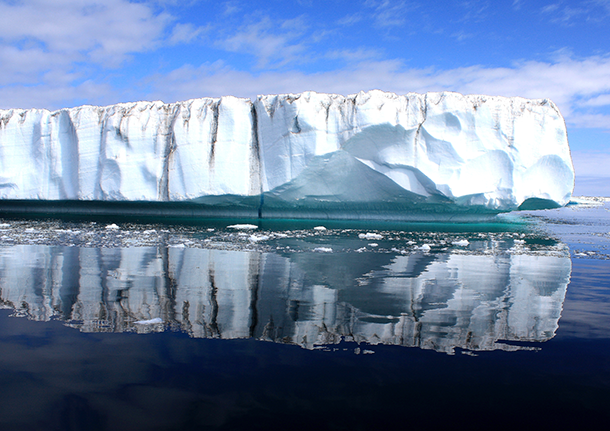
Increased melting of the Greenland Ice Sheet could slow down important ocean currents. (Photo: Christine Zenino; CC BY 2.0)
CURWOOD: It’s Living on Earth. I’m Steve Curwood. The Gulf Stream brings warm water north up the Atlantic coast of the US and feeds currents that help create Europe’s mild climate, and it may be in trouble. A study just published in Nature Climate Change suggests that this system of ocean currents that regulates temperatures might be changing. One author of this report is Michael Mann, Distinguished Professor and Director of the Earth System Science Center at Penn State University, who says there is cause for concern.
MANN: So there is ocean current, we sometimes call it the conveyor belt or the North Atlantic Drift. It's this current that brings warm water from the subtropical regions of the North Atlantic up towards Iceland and the northern latitudes in Europe. Well, we have long suspected that as we continue to warm the Earth and melt ice - the Greenland ice sheet, for example - as ice melts and runs off into the ocean it's freshening the ocean. And it turns out that when you freshen the ocean in the northern latitudes of the North Atlantic ocean, you make the surface waters less dense, and if you make those waters less dense, they no longer sink and they no longer drive this conveyor belt, this ocean circulation pattern, so there's this potential that we could see a substantial decrease or even a complete shutdown of this mode of ocean circulation which is so important for delivering heat to the high latitudes, keeping the climate of Europe moderate.
CURWOOD: Now, when you say it keeps Europe warm, we're saying places like England, which is far north of eastern United States - New York, Boston - tends to be much warmer and has an earlier spring.
MANN: That's right. And of course, Western Europe relies upon that moderate climate. If they were to lose that moderate climate that would obviously be problematic for them, for their economy. The pattern of climate, of rainfall, of drought, of temperature, that we rely upon today, and we rely upon the stability of those climate patterns for human civilization, well, if they were to change abruptly, that could really spell trouble, for us, for other living things, so any abrupt change in climate could potentially be catastrophic. We have long suspected that the North Atlantic Ocean circulation, the conveyor belt is one of those components of the climate system that could potentially undergo a very rapid change if we continue to warm the planet with fossil fuel burning and increased greenhouse gas concentrations. The climate models predict that we could see that current begin to shut down perhaps by the end of the century. As it turns out, the models appear to be too conservative because in our latest study we find evidence that that current is already weakening substantially and could be much closer to a total collapse than current generation climate models would suggest.
CURWOOD: Some of the things that you're describing echo the plot of The Day after Tomorrow, a Roland Emerick film.
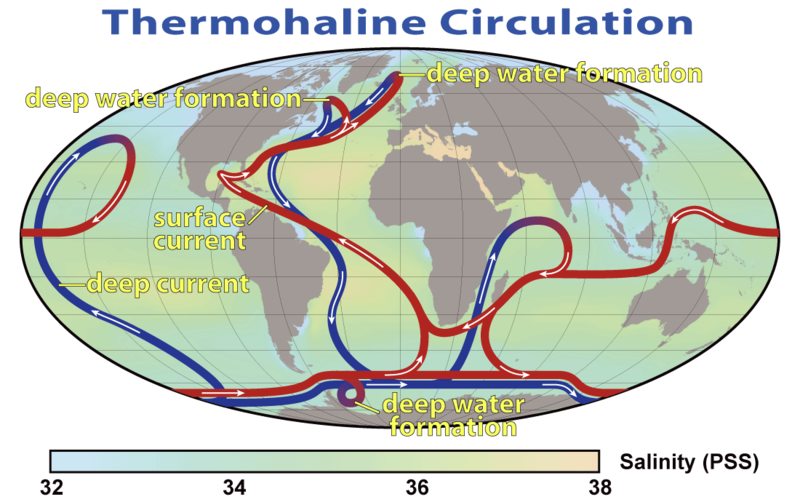
Thermohaline Circulation is the name of the conveyor belt current system that drives a lot of ocean circulation. (Photo: NASA Earth Observatory)
MANN: Yes, and I actually watch the movie with my first-year students and we picked holes in not just the plot but in the underlying scientific plans because while there's a grain of truth in the movie, and the grain of truth is the possibility that we could see a shutdown of this conveyor belt ocean current system, the fact is that it wouldn't play out over a few days, it would play out over a few decades. It wouldn't cause massive tornado outbreaks in Los Angeles or a return to ice age conditions throughout the entire northern hemisphere. The effects would be more subtle. But they would nonetheless be potentially detrimental. That's important to keep in mind as well.
One of the greatest concerns here is that if we did shut down the ocean circulation system, the conveyor belt, while we wouldn't get a new ice age in the northern hemisphere, we would fundamentally change the flow of nutrients that feed ecosystems in the north Atlantic Ocean, which is one of the most productive regions for sea life in the entire world, and we would potentially lose access to fish populations that we rely upon right now, at a time when we're already seeing threats to fisheries from ocean acidification, from overfishing. And so, while the impacts wouldn't play out like a Hollywood disaster film, they could still be disastrous for us.
CURWOOD: Now, in terms of this change in ocean circulation, when has this happened before in history?
MANN: Part of the original speculation for why this could happen, it wasn't based on climate models at all, it was based on the fact that this happened. It happened 12,000 years ago roughly, as we were coming out of the last ice age, it began to melt a whole lot of ice and all that fresh water flowed off into the North Atlantic Ocean where it formed this lens of fresh water, which inhibited this conveyor belt circulation. We think it shut down then. We didn't go back into a full-blown ice age but we did see a return to quasi ice age conditions in regions neighboring the North Atlantic.
So because it happened before in response to a natural warming - that was the warming because of changes in the Earth's orbit relative to the sun - now we are undergoing a different warming. We're warming the planet not from natural factors that act over thousands of years, but the human factor of increased greenhouse gas concentrations. It's a much more rapid warming, but there isn't nearly as much as ice around as the end of the last ice age. And so, there isn't the potential for quite as much of that fresh water running off into the North Atlantic. We don't think we're likely to see anything that severe. But it is the closest thing we have to an analog for what could happen to this current system due to human-caused global warming.
CURWOOD: Now, how soon might we see this? This year, for example, we had this exceptionally cold and snowy winter in the eastern seaboard to the United States. To what extent might this recent winter - actually it's not quite over, is it? - be related to maybe this slowing down of the North Atlantic conveyor belt?
MANN: Well, that's a great example of the cutting edge of the science. We're still trying to find the answers, figure out the answers to some of these questions. Some scientists think that these unusually severe winters we've seen in the northeastern US, these very strong Nor’easters, these huge snowfalls, could actually be related to another climate change impact, the loss of sea ice from the Arctic, and the way that is altering large-scale weather patterns.
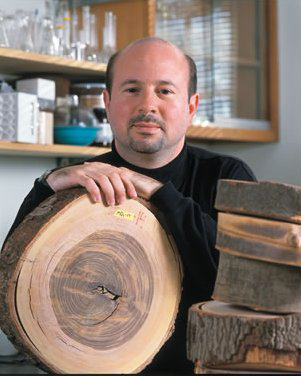
Dr. Michael E. Mann is Distinguished Professor of Meteorology at Penn State. (Photo: Penn State University)
But this slowdown in the conveyor belt circulation would also be impacting regional climates, potentially in such a way as to yield more severe cold winters in parts of eastern North America, but we can't rule that out either. We're still trying to figure out the answers to some of these questions, but the problem is that the uncertainty in this case - and you sometimes hear critics will say, "well, uncertainty is a reason not to act on climate change, we're not certain about what will happen" - well, actually, uncertainty is a reason why we should act, because this is yet another reminder of a nasty surprise that may in store in the greenhouse. If we see an abrupt change in this ocean current system, it could create problems that are even greater than we currently project.
CURWOOD: So maybe the loss of Arctic sea ice has changed where the jet stream goes and that has brought some of the cold weather east. And maybe this slow down, or slowing down of the Gulf Stream, the North Atlantic conveyor belt, might be another reason why things are getting colder in the east. I mean, it sounds like a bunch of things are going wrong all at once, or am I just being too negative here?
MANN: Well, you're right. It's the law of unintended consequences here. We are toying with what Wally Broker used to refer to as the "angry beast.” We're poking it with sticks, and that is not something that you want to be doing. The fact that we don't understand this system completely is a reason for even greater caution because it means we could be in for unforeseen consequences – so called climate surprises. Now, there is some good news here. I don't want to leave your listeners with nothing but pessimism.
CURWOOD: Please, go ahead, please, go ahead!
MANN: We are not yet committed to what we might envision as truly catastrophic climate change. Most climate scientists who study climate change impacts will tell you that if we can hold warming below to about two degrees centigrade, that's about three and a half degrees Fahrenheit, we would avoid some of the most disastrous impacts, and we might avoid a full blown collapse of this ocean circulation pattern. There is still time to act and we see some reason for optimism - there was a flat lining in global carbon emissions over the last year even while economic activity increased globally, some suggestion that maybe we're starting to turn the corner of decarbonizing our economy. There's a very important summit coming up later this year in Paris where many are hopeful that we will reach binding commitments to reduce carbon emissions even further. So there's some reason for optimism, but there is no question there is an urgency to acting on this problem now unlike anything we have ever witnessed before and our study is just another reminder of that.
CURWOOD: Michael Mann is Distinguished Professor and Director of the Earth System Science Center at Penn State University. He's also author of "The Hockey Stick and the Climate Wars: Dispatches from the Front Lines.” Thanks for taking the time with us today, Professor.
MANN: It was a pleasure.
Related links:
- Michael Mann’s paper
- NASA visualization of the conveyor belt circulation
What a Record-Low Snowpack Means for Summer in the Northwest
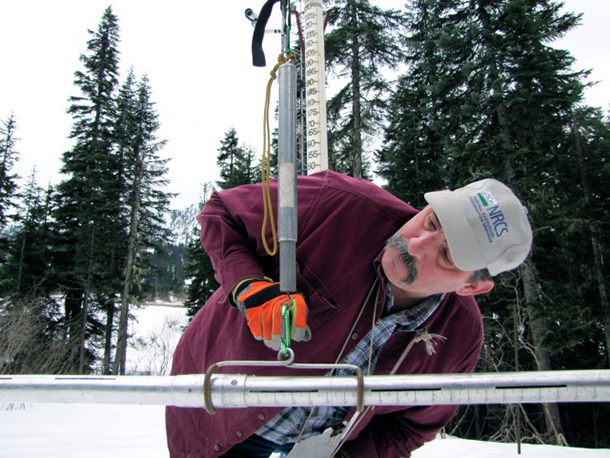
Scott Pattee, a water supply specialist with the National Resources Conservation Service, checks snow levels at Stevens Pass ski resort in Washington's Cascade Mountains. (Photo: Ashley Ahearn/KUOW)
CURWOOD: Now here in the eastern part of the country, we’ve been breaking snowfall records. But on the west coast, the snow season has been a bust, much to the disgust of would-be skiers. Indeed, snow levels were at record low level in Washington and Oregon. And that’s not only a problem for skiers – water utilities rely on snowpack for supplies during the summer. But as Ashley Ahearn of the public media collaborative EarthFix reports, it’s not time to hit the panic button just yet.
PATTEE: Alrighty, off we go. [walking on snow]
AHEARN: Scott Pattee screws together some aluminum tubes and walks over to stick them into the snow near Stevens Pass Ski Resort.
[PUTS TUBE IN SNOW, “33 INCHES DEPTH.”]
AHEARN: Pattee’s a water supply specialist with the Natural Resources Conservation Service here in Washington. He’s been monitoring snow levels to predict water supplies for more than 20 years. He says this is one of the worst years he’s seen. The Cascade Mountains around us are mostly brown and green, not white.
PATTEE: So you can see by that we have about 30 inches and normally we would have 120-150 inches, up here. Not good.
AHEARN: Snow levels in some parts of Western Washington are more than 90 percent below normal. Statewide, average snow level is 71 percent below normal. In Oregon, things are worse - the state has received less than a quarter of its normal snowfall, with the driest spots in the southern and southeastern part of the state.
But here’s the weird thing - and the reason Scott Pattee and other water managers aren’t freaking out yet - total precipitation is at or above normal for most of the Northwest. It’s just coming as rain, not snow.
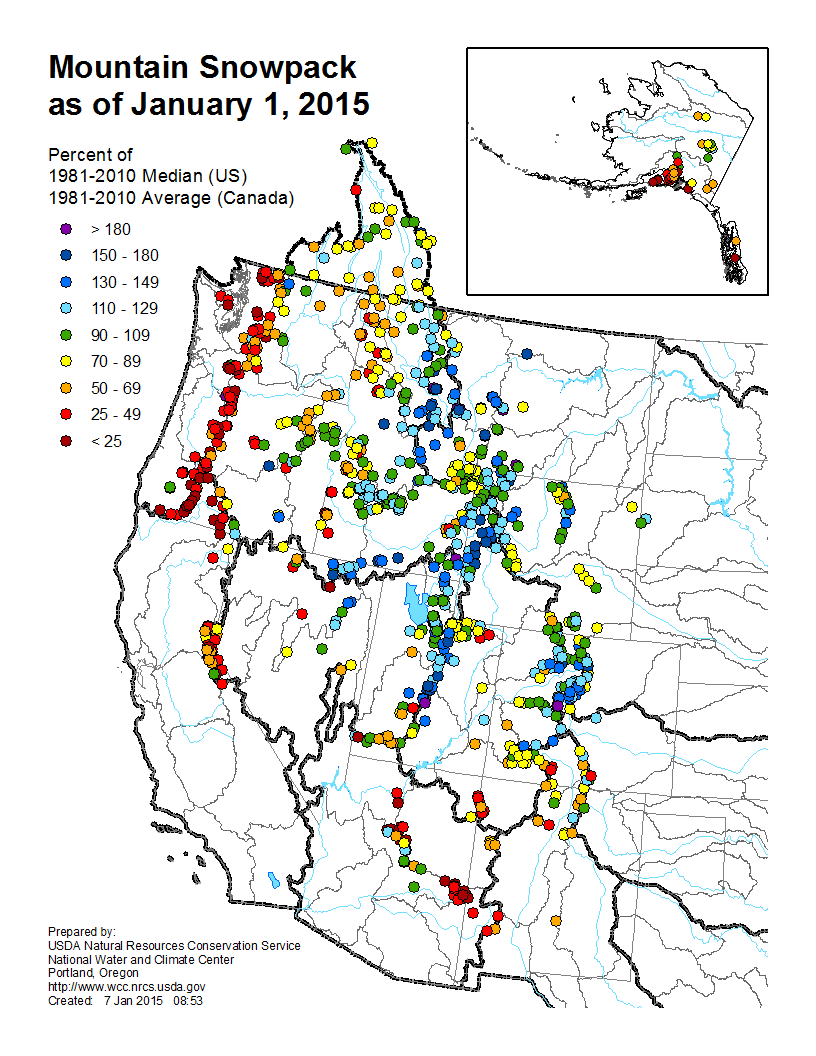
Mountain snowpack in the west as of January 1, 2015. (Photo: National Water and Climate Center, USDA Natural Resources Conservation Service)
HANSON: We’re doing just fine at the moment.
AHEARN: Mike Hanson is a spokesperson for Bonneville Power Administration. It manages 31 federal dams on the Columbia and Snake Rivers, and provides about a third of the electricity for the Northwest. He says that as bad as things might look out your window or on your local ski slope,
HANSON: That doesn’t give you the total picture. What’s really important to us is what is happening at the higher elevations throughout the northern Rockies going into Canada.
AHEARN: Snow levels there are looking pretty good, and Hanson says that snowmelt will feed into BPAs reservoirs on the Columbia and Snake throughout the season.
Many communities in the region depend on snowmelt to supplement water supplies during the dry months - especially those that get their water directly from snow-fed rivers and don’t have reservoirs to store water.
That’s not the case in Seattle. City water managers say their reservoirs have enough capacity to meet demand throughout the dry season, and they’re keeping them full in preparation.
Amy Snover is the director of the Climate Impacts Group at the University of Washington. She says that water supply systems vary throughout the region.
SNOVER: But in many cases, the water managers who are paying attention to the conditions can change the way they manage their systems and try to catch that water as it’s going down the river because it fell as rain instead of snow.
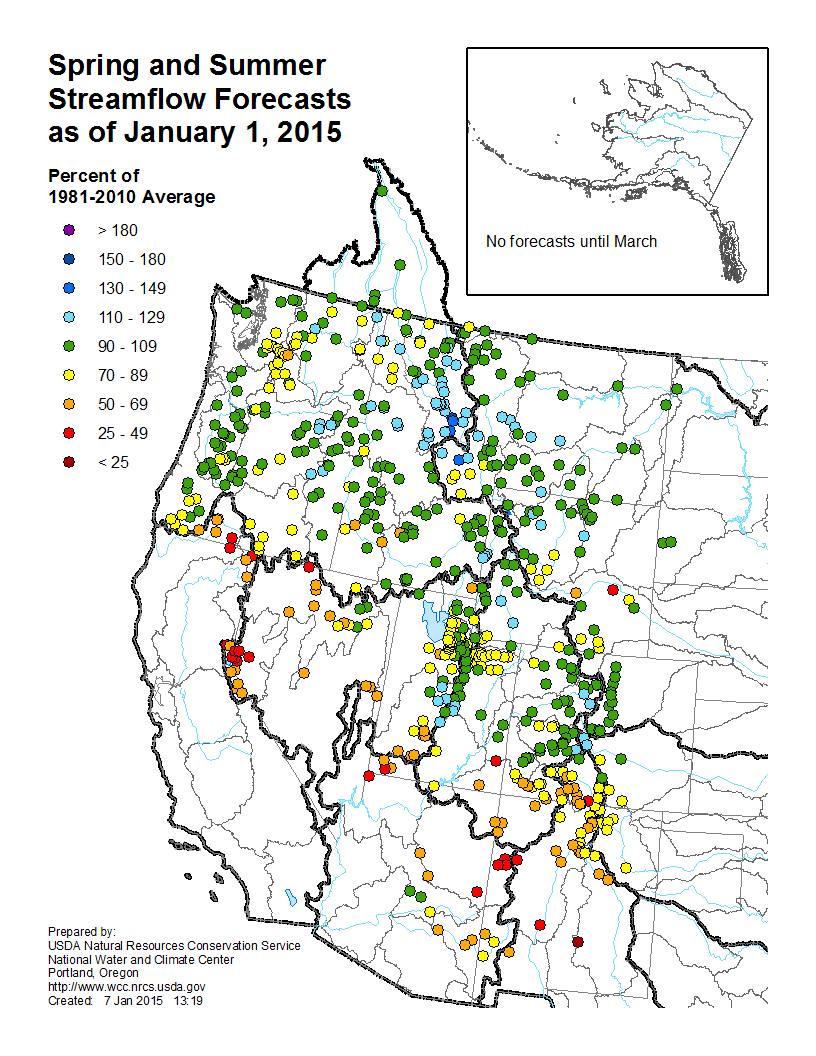
Spring and Summer stream flow forecasts as of January 1, 2015. (Photo: National Water and Climate Center, USDA Natural Resources Conservation Service)
AHEARN: Water managers and others have called the warm, rainy winter this year “anomalous”. Snover agrees, but she says it’s an anomaly worth looking at because this year’s weather patterns are in line with climate change projections for the region.
SNOVER: When people ask me about this year and whether this is global warming I say, well, global warming looks like this and I also say we’ll see a lot more of these, more frequently, as we go forward.
AHEARN: There could still be some snow this month, but experts say it’s unlikely that it will be enough to make up for lost snow this winter, and there could be droughts later on in the summer.
Water supplies for hydropower and people aren’t at dire levels yet, but scientists worry that without that pulse of cold snowmelt into rivers of the Northwest this spring and summer, spawning salmon and their young, will be the first to suffer.
I’m Ashley Ahearn in Seattle.
CURWOOD: Ashley Ahearn reports for the public media collaborative, EarthFix.
Related links:
- Learn more about the future of Northwest Snowpack on EarthFix
- Climate Change & Pacific Northwest Glaciers
[MUSIC: Sonny Stitt, There will never be another you, the Art of the Jazz Saxophone.]
Beyond the Headlines
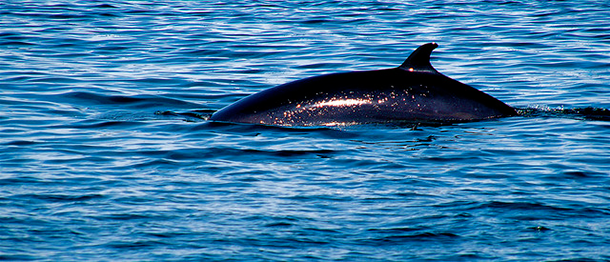
Two groups, the Environmental Investigation Agency and the Animal Welfare Institute, recently uncovered documents showing that Japan rejected imports of Norwegian whale meat because it was contaminated with pesticides. (Photo: Ville Miettinen; Flickr CC BY-NC 2.0)
CURWOOD: Time for a trip beyond the headlines now. Peter Dykstra’s been investigating, and he’s on the line from Conyers Georgia. Peter is with the DailyClimate.org and Environmental Health News, that’s EHN.org. Well Peter, what’s going on?
DYKSTRA: Well, hi, Steve. Let’s start out with a screwy little story from the high seas. Commercial whaling has been outlawed worldwide for over three decades. Some native communities are allowed to hunt whales on a subsistence basis and as part of cultural tradition, and most people, including myself, have no problem with that, but Japan’s commercial whaling industry has dodged the ban by claiming their whaling, and importing whale meat from Norway or Iceland, is for scientific research.
CURWOOD: Yeah, that’s been around forever, but it’s not exactly clear what kind of “research”, if any, comes out of it.
DYKSTRA: Well, unless you want to count the fact that some people are still making the scientific discovery that they think whale meat is delicious. But I digress. Recently, two groups, the Environmental Investigation Agency and the Animal Welfare Institute, uncovered documents showing that Japan rejected imports of whale meat from Norway due to pesticide contamination — chemicals linked to birth defects and cancer like aldrin, dieldrin, and chlordane.
CURWOOD: So it’s not just mercury, but also farm chemicals that are showing up in ocean animals?
DYKSTRA: Yes, and that’s something that’s been showing up with alarming frequency, particularly in the northern latitudes. Polar bears, seals, walruses and more – animals near the top of the food chain – can be the last stop for toxic chemicals as they bio-accumulate their way up that food chain. Not a happy story but a fascinating one in several ways. Where years of international laws and international scorn haven’t finished off commercial whaling, the discovery that some whale meat is unfit for consumption might do the trick. Secondly, it’s a powerful lesson that toxic chemicals – even if they’re used thousands of miles away and have been banned for years – have far-reaching impacts. And one more point, for which we’ll have to sound the irony alert.
CURWOOD: OK, we’re prepared. Launch your irony.
DYKSTRA: After 30 years of the sham of research whaling, some genuine scientific research – checking food for contamination – may help stick the fork in commercial whaling.
CURWOOD: Huh, saving whales by poisoning them. Kinda weird science indeed. What’s your next one this week?
DYKSTRA: Silenced science and climate comedy. Here’s an update on a story we discussed a couple of weeks ago. Florida Governor Rick Scott denies that there’s a state government ban on saying the words “global warming” or “climate change,” despite a staff attorney, a contract employee, and a scientist coming forward and saying there was an unwritten ban. This week, two more shoes dropped.
CURWOOD: Hmmm, let’s see – one, two – that would be like five shoes in total.
DYKSTRA: Well, five shoes, for now. Number four was a state environmental manager who filed a complaint saying he was formally reprimanded and sent home from work for bringing up climate change at a state meeting in February. Bart Bibler’s complaint also says he was directed to seek out his doctor to see if he was fit to do his job.
CURWOOD: Oh, my. So if his complaint is true, they’re saying that he was potentially crazy for mentioning climate change?

Five years ago this week, President Obama said, “It turns out, by the way, that oil rigs today generally don’t cause spills. They are technologically very advanced.” Ironically, just three weeks after this statement, BP’s Deepwater Horizon oil rig in the Gulf of Mexico exploded, creating the biggest disaster in American offshore history. (Photo: Nick Knupffer/Intel; Flickr CC BY-SA 2.0)
DYKSTRA: Which may be why the state’s Emergency Management Director figuratively buttoned his lips rather than say “climate change” at a state hearing. A Democratic state senator tries to get Bryan Koon to say those forbidden words, as bi-partisan hilarity breaks out among his Senate colleagues. There’s a link to this hilarious video on the LOE website.
CURWOOD: That’s LOE.org. You know, I just wish the rest of the climate news was always that funny. Hey, Peter, give us our weekly history lesson now, please.
DYKSTRA: One of the things you’ve got to love about broadcasting is that when you record someone’s words, you can hold them accountable. Forever. President Nixon said, “I am not a crook.” The first President Bush said, “Read my lips.” President Clinton when he wagged his finger at America and said “I did not . . . have . . . yada yada yada.” But one of my favorites from President Obama came out five years ago this week, and I bet he wishes he could reel this one back.
[CLIP OF OBAMA SPEAKING] “It turns out, by the way, that oil rigs today generally don’t cause spills. They are technologically very advanced.”
CURWOOD: Well, it wasn’t such a big deal when he said it.
DYKSTRA: But three weeks after he said it, the Deepwater Horizon Spill became the biggest disaster in American offshore history. Eleven men died when an oil rig exploded, leading to an ecological disaster for the Gulf of Mexico and an economic one for the seafood and tourism industries along the Gulf. The fifth anniversary of the explosion and spill will come next month. President Obama’s confident words about oilrigs were related to opening up more offshore territory for oil and gas drilling. That effort was put on hold, but from the Arctic to the Atlantic coast, there’s pushback lately to expand drilling off our coastlines.
CURWOOD: And you can get all of our words, audio, the podcast, on our website, LOE.org. Peter Dykstra is with Environmental Health News – that’s EHN.org – and DailyClimate.org. Thanks Peter, for taking the time with us.
DYKSTRA: All right, Steve, thanks a lot, we’ll talk to you soon.
Related links:
- “Japan refuses Norway’s toxic whale meat”
- “Florida environmental staffer says he was reprimanded for talking about climate change”
- Video: Florida lawmaker mocks Rick Scott official for refusing to say ‘climate change’
CURWOOD: Coming up...the challenge of teaching evolution in the heart of the bible belt. That's just ahead on Living on Earth. Stay tuned.
ANNOUNCER: Funding for Living on Earth comes from United Technologies, a provider to the aerospace and building systems industries worldwide. UTC Building & Industrial Systems provides building technologies and supplies, container refrigeration systems that transport and preserve food, and medicine with brands such as Otis, Carrier, Chubb, Edwards and Kidde. This is PRI, Public Radio International.
[CUTAWAY MUSIC Steve Reich, Music for 18 Musicians 11 section 1 2005 Nonesuch]
Defending Darwin

"Evolution" 1992, oil on wood panel, 96 x 288" (Image: courtesy Alexis Rockman and Sperone Westwater Gallery)
CURWOOD: It's Living on Earth. I'm Steve Curwood. A number of fundamentalist Christians believe that the bible is the word of God and trumps all human knowledge, including the scientific evidence that life has been evolving on Earth for millions of years. These creationists believe God created the Earth and its inhabitants over the course of just seven days, roughly 6,000 years ago. So of all the difficult jobs one might imagine, teaching evolution in America’s bible belt must rank near the top. But there are dedicated educators who choose this thorny path, and one of them, a biology professor at the University of Kentucky, wrote his personal story in Orion magazine. It was so engaging, I went to visit him.
KRUPA: Hello, my name is Jim Krupa, I'm a professor here at the University of Kentucky. I teach evolution and vertebrate biology. We're outside of my laboratory in this glorious windowless building where all biologists are kept.
CURWOOD: [LAUGHS] We'll I'd like to see inside.
KRUPA: Let's go on in.
[KEY TURNING IN LOCK]
CURWOOD: Jim’s lab looks like a cabinet of wonders or a natural history museum, with a huge stuffed sailfish behind his crowded desk and skulls all along the walls.
KRUPA: Well, some of these skulls are really fascinating - there’s a gorilla up there that's been at this university since 1870. It's so fragile I don't even touch it. There is a leopard skull that apparently died at the 1904 World's Fair in St. Louis. I think it's interesting because Teddy Roosevelt was at that fair. There's a chance he may have looked at that animal. And then an old wolf's skull from Alaska, Kodiak grizzly from Alaska, all of these have been here for over 100 years. Any kind of road kill that I might happen upon I will clean up and use for teaching, so all sorts of good things here, hundreds and hundreds of skulls.
CURWOOD: But not every exhibit in Jim’s lab is long dead. We walk over to a series of tanks filled with snakes.
KRUPA: The ones over there the green ones are Japanese rat snakes. I've had them since they hatched and they don't like me very much. This one is a very pretty snake. It's called a milk snake. 'Hi, how you doing.' So this is a gorgeous animal.
CURWOOD: Oh, wow, look at that.
KRUPA: They normally don't bite.
CURWOOD: It's red...it's actually sort of a vivid pink almost, and black and white band.
KRUPA: Reddish orange so it's a mimic of the deadly coral snake. So the old saying is, red on black, friend of Jack, red on yellow, kill a fellow. So, if it's red on yellow, it's a coral snake in North America, but I don't have any of those, so this basically a mimic of a poisonous snake.
CURWOOD: There's one next to it from South Africa.
KRUPA: Yeah, all these African Egg-eating Snakes from South Africa. I like them when I don't see them that means they're happy and healthy and fed. He likes to act tough...there you go...so he's now...
CURWOOD: I want to see what he's going to say.
[SNAKE HISSES]
CURWOOD: Whoa!
KRUPA: It has almost no teeth so it's pretty much defenseless, so it basically mimics a venomous snake from Africa, the Rhombic Viper I think it is. So yes, if you can't be tough, look tough, act tough and keep people away.
CURWOOD: Jim’s academic research, though is not on animals – but on plants that eat animals.
KRUPA: Alright so here we have Venus fly traps getting ready to go into flower. They've been dormant, now they're starting to bounce back. These are some more carnivorous plants. These are pitcher plants from Australia here and here.
CURWOOD: So they're meat eaters but they're lovely...
KRUPA: Insect capturing. Oh, they're very beautiful. They were Darwin's favorite plants. He wrote an entire book on carnivorous plants. Yeah, there are 600 species all around the world.
CURWOOD: I suppose it's fair. If we eat plants, they should get a crack at eating animals.
KRUPA: Yeah, and they need it. Insects fall in and they get the nitrogen and the phosphorous and they don't have to get it from the soils so they can grow in nutrient poor soil because they get their nutrients from elsewhere. So, it’s a very interesting adaptation.
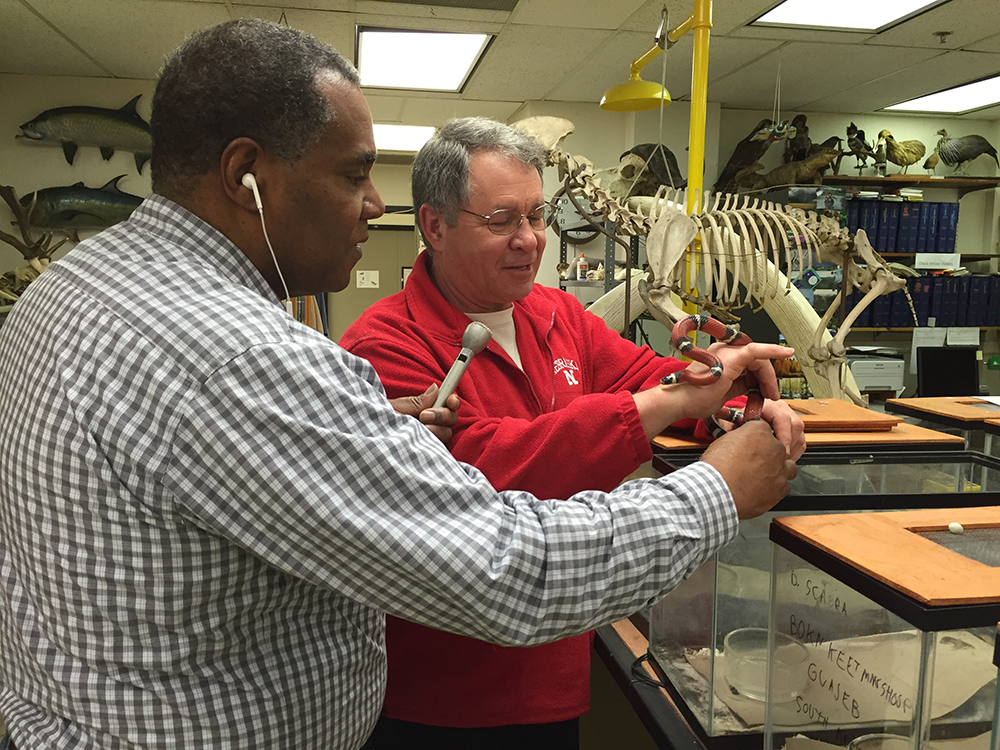
Jim Krupa and Steve Curwood holding a Milk Snake (Photo: Anastasia Curwood)
CURWOOD: As well as studying pitcher plants, for the past 20 years Jim has spent much of his time teaching an introductory biology course, including evolution. Some fundamentalist students challenge him, but there’s a long tradition at the University of Kentucky of scholars who defended the great evolutionary theoretician Charles Darwin. In fact one of UK’s most famous alumni is John Scopes, who was put on trial in neighboring Tennessee 90 years ago for teaching evolution. The so-called Scopes Monkey Trial was the first major trial broadcast on the radio and the epic battle between its two famous lawyers, presidential contender William Jennings Bryan and Clarence Darrow, riveted audiences across America. But as Jim points out, the fight for academic freedom had already been narrowly won in Kentucky.
KRUPA: 1921, 1922, Kentucky was the first state where there was a movement to pass an anti-evolution bill where one of the forms of the bill had it such where there could be a $5,000 fine for teaching evolution and up to a year in prison. So it was a very hard-fought battle to stop this anti-evolution movement from happening, hence the University of Kentucky's Frank McVey, one of the great presidents, was the one who really stood up and fought it. He spoke to the politicians in Frankfort, Kentucky, he wrote letters. On, as it turned out, Darwin's birthday, which is Abraham Lincoln's birthday, so the 12th of February, 1922, he wrote a letter to the people of Kentucky explaining this was an attack on the university, an attack on academic freedom, an attack on one's religious beliefs and that this law would do incredible damage to the university and the state. And as a result, a few weeks later, the final vote came down to a 42-41 vote defeating the bill, the law, so off the attention went to Tennessee. So it was really a marvelous thing because he put his job on the line.
CURWOOD: And during this, there is a student at the University of Kentucky named John Scopes. What happened with him?
KRUPA: Yes, isn't it amazing. All this is going on. John Scopes is watching this unfold. His three favorite teachers - Professor Miller, Professor Turell Professor Funkhauser - were heavily engaged in the battle helping Frank McVey. William Jennings Bryan was in town giving talks on this, he was attending the talks. From here in 1924, Scopes took a teaching position in Dayton, Tennessee, teaching chemistry and the football coach and he did a little substitute teaching in biology. And so, he basically offered himself up to be the person that was charged for teaching evolution in Dayton, Tennessee, and he stepped into history, in part, because he was inspired by his teachers here at the University of Kentucky and President McVey.
CURWOOD: Jim, so, what did you think when you were offered a position to teach here at the University of Kentucky?
KRUPA: Oh my God, I don't want to teach hundreds and hundreds of students in giant classrooms. I want to teach a little class of 25 students where and hold my skulls and have them hold snakes. It was scary because an auditorium full of students, that's a daunting teaching environment and I wasn't sure I could do it so I was very apprehensive about taking the job at first.
CURWOOD: And what about the place's reputation. I mean, this part of the country, a lot of folks who are still very upset about the notion of evolution?
KRUPA: Well I got my PhD at the University of Oklahoma and it isn't any different there, so I was used to this environment by the time I got here, but you know that didn't matter because evolution is the foundation of our science so I don't care what the general public thinks about it, this is what...it defines biology...this is what I'm going to teach.
CURWOOD: Now, you write that EO Wilson inspired you to take this job. What did he say that got you to say, "Yeah I can do this."
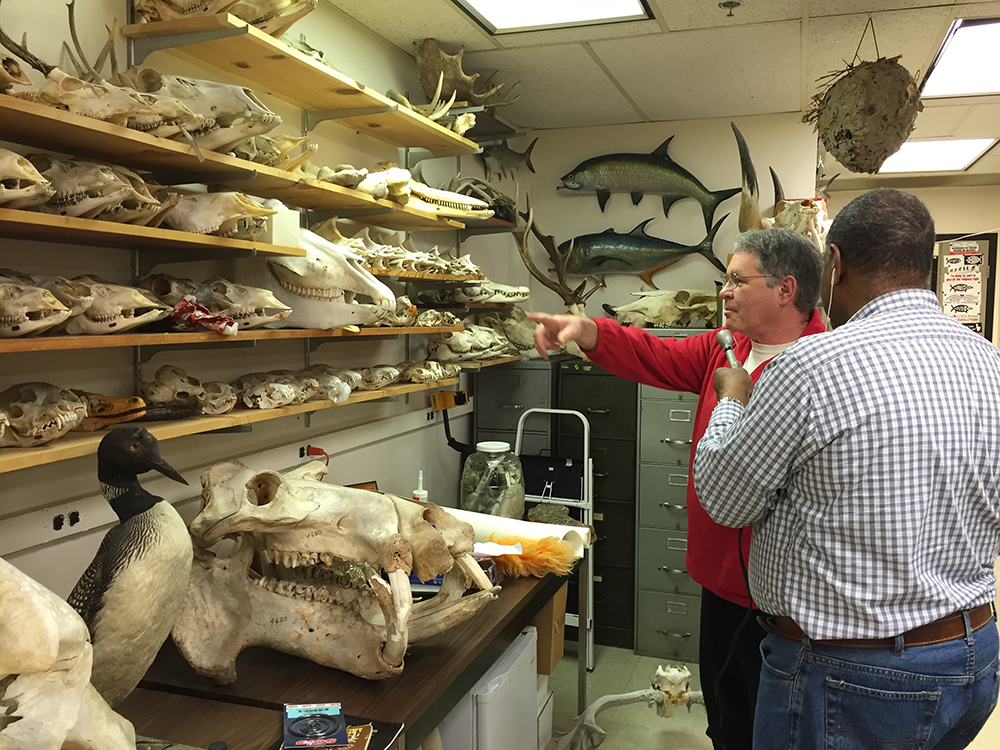
Jim Krupa’s lab is filled with animal skulls from all over the world. (Photo: Anastasia Curwood)
KRUPA: Well, he didn't say anything to me personally, but it was right around the time where his autobiography came out, and the title is "Naturalist" which I love being one, but he was being interviewed on NPR and Bob Edwards asked him why he was still teaching introductory biology at Harvard when he is one of the most famous biologists, but what he said to Bob was it's the most important course that he could teach. Many of nation's leaders, being at Harvard would be taking that class, and so this is the last shot he had at convincing them that science and biology is something wonderful. So, he had to do it because he knew it was a very important course, and that's what kept me here, because I was still thinking about leaving but sometimes you have to do something for a greater good. And it turned out I have a knack for teaching big classes so it was kind of fun.
CURWOOD: So, what was it like when you first started? I mean, how much push back did you get from some of the students in your class?
KRUPA: Well, not a lot, face to face. Most of it, at the end of the semester when we get the written comments on our teaching evaluations, that's what shocked me, and I have pages and pages of written comments about, "You have no right to teach us evolution. It's not science. It's religion. It's atheism. You shouldn't be teaching it." Da da da da. But again, that's a small percent of the students, but a vocal minority can make a lot of noise.
CURWOOD: Yeah, tell me about some of those tense moments with what you call the vocal minority.
KRUPA: I had the one student who shouted from the back of the auditorium that Darwin denounced evolution on his deathbed and therefore I shouldn't be teaching it. Of course, that's a lie. The creationist who made that up admitted it, and that was a strange thing to have a student shout out and then walk out. And I've had that not quite a dozen times over 20 years so it throws you for a bit of a loop every time.
CURWOOD: What do you say to folks that evolution is a theory and therefore not a fact?
KRUPA: Well, I have to explain to them what theory is, and I'm kind of a grumpy old man in many ways. I get upset every time I hear the word "theory" being used incorrectly, which is on a daily basis, but I explain to them that a theory is this broad comprehensive of some aspect of nature that generates testable and falsifiable predictions. It's not a hunch, it's not a notion as people think, so I try to make the point very clearly of what theory is, and I do explain that as one of the most powerful tools that science has. It's what we base what we do on. And then I explain a fact versus hypothesis, but I make it very clear what a theory is, I make it very clear what a fact is, and that evolution is both. And of course, I'll have people say, "No. It can't be. It has to be one over the other." And my response is always, "Well. We have something called cell theory and yet it's a fact we are made of cells. We know gravity exists, but it's called gravitational theory. We know pathogens are what cause disease but it's still germ theory." So, I go at it to a point where it's ridiculous. But you have to keep making the point over and over and over.
CURWOOD: To what extent did you address religion in those introductory classes?
KRUPA: Well, in human ecology, I don't touch it at all, but in the non-majors general biology I really didn't touch it until the very end. But in the last lecture I give them what I call the social resistance to evolution lecture and that's where I hit it head on. That's where I explain all the Christian denominations that accept evolution; I give them plenty of examples of evangelical Christians who defend evolution, so Francis Collins, the director of NIH, evangelical Christian. My job is to explain to them that when somebody, their parents, their ministers, their friends tell them that it's either evolution or God, you can't have both, I point out that's an error and I give them as many examples of Christians of various denominations who are also evolutionary biologists and say, "So here you go. This line is blurred." And so that's the last lecture. That can be the lecture that gets me the most stressed and worked up ahead of time because this is where I'm going to have some people that are upset that I'm even saying this. So I had to think about this for years...well, maybe a year whether or not I should do this lecture and I actually talked to my chair at the time and said, "So, there's not a problem with talking about the social resistance to evolution and the religion and science clash?" And basically, he says, "It's academic freedom. You need to hit it head on." And so, I've been doing it ever since.
CURWOOD: How do people react when you teach about climate change, climate disruption?
KRUPA: Same thing. When I got out of the non-majors classes it seemed that they were being less upset about evolution but more upset about this climate change stuff. And the statistics are a larger percent of Americans don't accept climate change so a lot of push back, same kind of push back, teaching evaluations are loaded with comments about I shouldn't be teaching it, it's not true, there's no evidence, stick to the facts and on and on. It's a very frustrating thing to see, and that's not connected to religious beliefs, that's rejection of science. So, yeah, it's very, very frustrating. So I got beaten up very thoroughly teaching those two topics.
CURWOOD: So what do we need to do as a country, as a society to foster better acceptance of science?

Jim Krupa with a pair of ancient elephant tusks (Photo: Anastasia Curwood)
KRUPA: Well we need better science education. I think we need to help all the teachers by giving them a stronger foundation of evolutionary biology, climate change, and help give them the tools to deal with the parents that are going to reject it. So we have to help the teachers. We have to train future teachers better so basically we in academics, the university level academics are the ones that are failing here, but things need to be changed so, it's not just paying teachers more. We need to help them be trained better. Any teacher that will be teaching high school biology, we really should have them take an evolution course. The National Center for Science Education is there to help any teacher that needs the help, and they're doing workshops. They put a lot of effort into this so we've got to provide the information for the teachers. We've got to help them, because, well, they're teaching their guts out. So how do we make this nation more accepting of science? The anti-vaccination movement, how do we deal with that? The anti-climate attitude, how do we deal with that? It's a frustrating thing. So if someone has the answer, we need to hear it.
CURWOOD: You end the piece you wrote in Orion Magazine with the story of a run-in with a former student who, well, wasn't very accepting of your lessons on evolution but then went on to become a physician. Tell us about it please.
KRUPA: This is a great story. I taught a freshman seminar called Evolutionary Medicine. He took the class, evangelical, believed in the literal truth of the Bible and the Genesis, and he really struggled with this evolutionary medicine stuff, but he stuck with the class. And we had several encounters over the years where I saw him, I think it was probably, oh, it's been several years now, I was out on the road bicycling. And I was at about my 20th mile; he was probably on his 50th mile. And being much younger he shot by me and he came back and he recognized me. And we had a long talk while we're bicycling and he told me that he after the class went and listened to a number of Creationists and was really pretty embarrassed and appalled that fellow evangelical Christians were basically lying and he recognized they were lying. And he said, I realize now, as you said, I can have my religious beliefs and accept evolution. And so he thanked me and off he went.
And so, I had not seen him for a while and actually about a year ago I was in the hospital, I got hit with pneumonia where I almost died a couple of times and so I'm laying on this bed in emergency here at the University of Kentucky and here he came in as a resident and we had a great talk and he hoped that I was well and that he was just finishing up and he was I think joining Doctors without Borders and then I saw him for the last time this summer. I walked by him on the way to the hospital and he was thrilled to see that I was doing OK and the first thing he said with a huge smile on his face was, "You turned my world upside down. You blurred the lines between black and white." And then he thanked me. And it was just pretty marvelous to see that here is at least one student out of my 24,000 students that realized that he could have his faith and accept evolution and it was OK. And that made it worthwhile, it was like I might as well hang it up and retire now. I have a victory.
CURWOOD: Jim Krupa is a Biology Professor at the University of Kentucky. His article in Orion is called "Defending Darwin". Thanks for taking the time with me today.
KRUPA: You bet. Thanks. This was great fun!
Related link:
Dr. Jim Krupa’s Essay “Defending Darwin” in Orion Magazine
[MUSIC: Bela Fleck, Stomping Grounds, Live Art, Disc 2 Warner Bros 1995]
CURWOOD: Living on Earth is produced by the World Media Foundation. Our crew includes Naomi Arenberg, Bobby Bascomb, Emmett Fitzgerald, Lauren Hinkel, Helen Palmer, Adelaide Chen, Jenni Doering, John Duff, James Curwood, and Jennifer Marquis. Our show was engineered by Tom Tiger, with help from Jake Rego Noel Flatt and Jeff Wade. Alison Lirish Dean composed our themes. You can find us anytime at LOE.org - and like us, please, on our Facebook page - it’s PRI’s Living on Earth. And we tweet from @LivingOnEarth. I'm Steve Curwood. Thanks for listening.
ANNOUNCER1: Funding for Living On Earth comes from the Grantham Foundation for the protection of the environment, supporting strategic communication and collaboration in solving the world’s most pressing environmental problems. The Kendeda Fund, furthering the values that contribute to a healthy planet, and Gilman Ordway for coverage of conservation and environmental change. Living on Earth is also supported by Stonyfield Farm, makers of organic yogurt, smoothies and more. www.stonyfield.com.
ANNOUNCER2: PRI. Public Radio International.
Living on Earth wants to hear from you!
Living on Earth
62 Calef Highway, Suite 212
Lee, NH 03861
Telephone: 617-287-4121
E-mail: comments@loe.org
Newsletter [Click here]
Donate to Living on Earth!
Living on Earth is an independent media program and relies entirely on contributions from listeners and institutions supporting public service. Please donate now to preserve an independent environmental voice.
NewsletterLiving on Earth offers a weekly delivery of the show's rundown to your mailbox. Sign up for our newsletter today!
 Sailors For The Sea: Be the change you want to sea.
Sailors For The Sea: Be the change you want to sea.
 The Grantham Foundation for the Protection of the Environment: Committed to protecting and improving the health of the global environment.
The Grantham Foundation for the Protection of the Environment: Committed to protecting and improving the health of the global environment.
 Contribute to Living on Earth and receive, as our gift to you, an archival print of one of Mark Seth Lender's extraordinary wildlife photographs. Follow the link to see Mark's current collection of photographs.
Contribute to Living on Earth and receive, as our gift to you, an archival print of one of Mark Seth Lender's extraordinary wildlife photographs. Follow the link to see Mark's current collection of photographs.
 Buy a signed copy of Mark Seth Lender's book Smeagull the Seagull & support Living on Earth
Buy a signed copy of Mark Seth Lender's book Smeagull the Seagull & support Living on Earth

